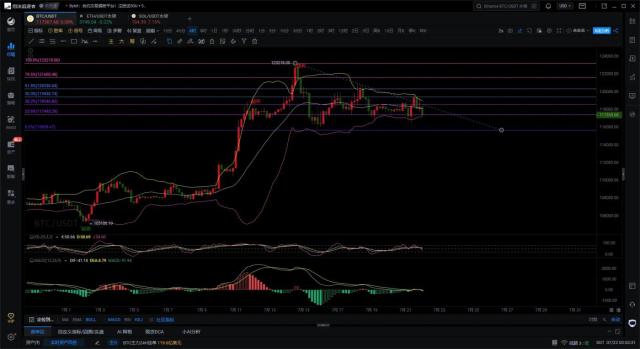Guest Lineup:
James - DFG Founder and CEO
Du Juan - Vernal Founder
Lily - D11-Labs Cofounder
Yang Mindao - dForce Founder
Host:
Angela Tong - DFG&Jsquare CMO
Topic One: What are the core driving factors behind BTC's new high, and is it sustainable?
1. This year, crypto market cap broke $4 billion, BTC reached a new high of $120,000, and over 90% of Ethereum addresses are now profitable. In your view, what is the "trigger" for this rally?
James: From an overall perspective, the main reason is liquidity. During rate hike cycles, both crypto and stock markets typically enter a bear market or experience a pullback. Currently, we are in a rate cut cycle with abundant market funds, making it easier for quality assets to gain buying support. Additionally, this rally is accompanied by significant events like Bitcoin ETF approval and large BTC purchases by companies like MicroStrategy, further driving funds, especially institutional and retail investors, directly or indirectly into the crypto industry. The combination of these two factors is a key reason why Bitcoin has risen to $120,000 without a pullback.
[The rest of the translation follows the same professional and accurate approach, maintaining the original structure and meaning while translating to English.]Topic Two: Is the Recovery Signal of ETH Real? What Does It Mean for the Future Market?
1. ETH Has Been Incorporated into Multiple Listed Companies, Is This a Long-Term Positive for ETH?
James: After Bitcoin rose to 120,000 and stabilized, mainstream funds turning to speculate on Ethereum is not surprising. Previously, the structure has shown that Ethereum has gained a certain degree of mainstream capital recognition, and its DeFi on-chain TVL data is relatively authentic. When the bull market turned to bear market in 2021, Ethereum and Bitcoin fell by similar margins, belonging to anti-fall assets. In this bull market, mainstream funds traditionally prioritize Bitcoin allocation, driving its bull market pattern. Now Ethereum's catch-up is a natural logical progression. From our perspective, Ethereum remains attractive long-term. On one hand, it's recognized by mainstream, on the other hand, its on-chain DeFi applications are active, with TVL accounting for over 50-60%. Currently, TVL and FDV have not reached new highs, and compared to that, Solana's additional issuance might be more. Overall, we remain optimistic about Ethereum's medium to long-term performance in this cycle.
2. Can ETH's Price Recovery Draw Attention Back to the Ethereum Ecosystem?
James: First, I don't think there's a question of "taking back". Even at Solana's peak, its market value never approached Ethereum's. In terms of TVL, over 50% has always been on Ethereum. It's just that industry hotspots, like Trump coin bringing a wave of meme coin trends, made Solana's ecosystem slightly hotter. But Ethereum's status as the "chain king" has always been there, it's just a matter of how far it is from others.
Mindao: What's interesting is that when we discuss Ethereum and Solana, we're actually discussing whether the blockchain future is a multipolar or unipolar world. Ironically, the Ethereum community often says "Bitcoin is the idea, Ethereum is the execution". While the "multi-chain" concept was first proposed by Polkadot and Cosmos, Ethereum actually executed it better. You could say Ethereum "copied the homework" but did it more successfully.
Looking at this cycle, I believe the future will definitely be a multi-chain world. Early on, BSC, Huobi, and OK all did their EVM chains. In this round, Coinbase and Kraken have launched L2 based on Ethereum. Recently, Robinhood issued assets on Arbitrum, with plans to launch its own L2 using Arbitrum Stack. In the future, entities like JP Morgan or BlackRock wanting to create a chain or issue assets will want to do so in a controllable environment, further verifying the multi-chain trend.
One advantage of Ethereum is its willingness to be compatible with traditional finance. Politically, there are 195 sovereign countries in the real world, indicating a multipolar structure. The blockchain world won't be dominated by just three or four chains. In this multipolar landscape, Ethereum's multi-chain architecture might make it the core of blockchain infrastructure.
Moreover, Ethereum-related strategy companies operate differently from Bitcoin. Bitcoin treasury companies like MicroStrategy are more like passive reserves. Ethereum-based companies like Sharplink not only bring stock market funds onto the chain but also push on-chain assets to the stock market, actively participating in on-chain DeFi like Staking and LSD. In the future, companies like Sharplink and Bitmine investing TVL in DeFi might drive infrastructure upgrades. I'm more looking forward to scenarios where listed companies issue DeFi convertible bonds on-chain and directly interact with DeFi protocols. Even protocols like AAVE might one day issue convertible bonds on the stock market, using raised funds to support on-chain liquidity. Recently, Ethena announced going public via SPAC as a stablecoin protocol, which is also a trend.
Dujun: First, why do I like Curve? Because it's essentially the "foreign exchange market" of the on-chain world. If this succeeds, it could be a $10 billion company, while its current market value is only around $1 billion. Basically, there are no real challengers, including Uniswap v3. Moreover, after the founder Michael's lending liquidation incident, the project has achieved complete decentralization. That's why I like Curve. Second, both last year and now, I've been optimistic about Ethereum. One point is worth emphasizing: in today's blockchain world, apart from Bitcoin, only Ethereum has truly achieved complete decentralization and a relatively neutral identity. Other chains either lack sufficient decentralization or technological maturity.
When discussing what problems blockchain can solve, I believe we should first focus on the "financial" domain, such as bringing real-world assets (RWA) on-chain. Which chain would these assets choose for deployment? Clearly not small chains. For large funds, institutions, or even sovereign nations at the $1 billion or $10 billion level, they'll only choose a chain with high decentralization and neutrality - Ethereum. So I believe that currently, Ethereum has no real challengers. Whether in maturity, ecosystem, or developer numbers, it's the strongest. I remain firmly bullish on Ethereum. If blockchain truly rises on a large scale, Ethereum will definitely be a very high-quality core target.
Topic Three: Why Are Altcoins Performing So Differently? Is There Still a Chance for Correlation?
1. Has This Altcoin Correlation Trend Ended or Not Yet Started?
Lily: I believe this altcoin trend hasn't truly begun and is far from over. Differentiation is inevitable. Projects like EOS have passed their peak and are now making new attempts. Like the stock market, the top 50 companies from a century ago are completely different today, and long-term success depends on continuous team management. Currently, altcoins are mainly divided into two categories:
The first is emotion-driven, like the meme coin representative Pump. Although it has recently pulled back, its circulating market value is still in the tens of millions, with daily revenues of millions. The core of such projects lies in "human nature" and "narrative", with many CEX contracts amplifying this psychological game.
The second is application-driven, and I personally firmly support DeFi. Because Crypto first changed the financial system, especially payment systems. Like the recently hot Xstock, issuing and trading stocks on-chain with 7x24 non-stop trading, which traditional markets can hardly achieve short-term. For instance, Nasdaq plans to achieve spot 7x24 trading by 2026, and options markets don't even have a timeline. DeFi's advantage is that it can already provide these infrastructures, just needing more liquidity and user education. Future traditional asset pricing mechanisms might also migrate on-chain. So I believe DeFi projects like Curve that serve real financial scenarios will become crucial infrastructure for the entire industry. Of course, the combination of AI and Crypto is worth watching. Both AI for Crypto and Crypto for AI have opportunities, but currently, except for data confirmation and partial interaction scenarios, they might not have found a point that can release massive energy. But it will definitely be a major track worth betting on in the future.
2. How to view the subsequent development of AI and DeFi sectors?
James: Bitcoin itself is a product of the financial crisis. It was precisely because of problems in the traditional financial system that Bitcoin was born. If you want to find the most "pragmatic" direction in the blockchain industry, DeFi is undoubtedly the most solid and meaningful. Currently, mainstream DeFi protocols, especially Blue Chip level ones, are generally profitable from a financial data perspective, and their product systems are mature. Comparing traditional finance and on-chain DeFi, the differences are significant. Offline financial services are more oriented towards high-net-worth clients, making it difficult for ordinary people to obtain quality services; while DeFi is fairer and more open. Traditional financial institutions can even ban accounts based on vague user agreements, whereas on-chain rules are transparent and trustworthy. Additionally, DeFi continues to evolve in product experience, stability, and innovation. Although there were security issues during the DeFi Summer, mainstream protocols on Ethereum have now become mature, able to generate stable profits and provide continuous high-quality services. Therefore, we will focus on configuring leading projects in the DeFi track in the secondary market, such as DEX and lending. In the long term, DeFi is the track we are most optimistic about among all tracks.
As for the AI direction, I do not have a technical background, so my understanding is limited. Currently, most Crypto+AI projects are still narrative-driven, with few actual product implementations. The key to the future growth of this track lies in whether large-scale applications can be realized, with real users using the products. If it's just about concepts, the narrative's heat will be difficult to sustain, and investment risks will be higher. However, once a blockbuster product appears, it might experience explosive growth. Many CryptoAI project valuations are still low, such as Render and Near that we mainly hold, which are not expensive. The key going forward is still whether there will be actual implementations.
[Translation continues in the same manner for the rest of the text]2. For startup projects, have the preferences of VCs, CEXs, and traditional funds changed?
James: Currently in a bull market with rising crypto prices, many "crypto stocks" companies naturally prefer to benchmark crypto assets and are even very proactive. However, in a bear market with sustained price declines, these companies' asset values might be significantly discounted or even experience an "inversion" phenomenon. I completely agree with this point. That's why we've always been very cautious in our investments. Although we've received many good investment invitations, with various crypto stock companies hoping we'll participate, such as those dealing with Ethereum, Solana, or other crypto assets, we haven't invested in any so far. Of course, this doesn't mean we won't invest in the future, just that we'll be more cautious. Especially for companies that aren't mainstream, haven't reached the top tier, but have high valuation premiums, we believe they offer little value to long-term investors. In contrast, we're more inclined to invest in companies with genuine product capabilities, clear business models, potentially profitable, and likely to be listed on US stocks in the future, like Circle, Ledger, and CoinLis - teams that are industry leaders with real users and revenue. This type of company better aligns with our investment logic of focusing on "long-term value".
Mindao: The recent "crypto stocks" wave on Wall Street is indeed hot, but from my perspective, there are few companies truly possessing long-term value. Bitcoin-related top companies like MicroStrategy are indeed valuable because they use real money to issue debt, stocks, and use structured products to net buy Bitcoin in the market. In comparison, Ethereum and other public chain crypto stock companies have structural differences. Many such companies issue additional shares through PIPE, introducing existing token holders, and then use raised funds to repurchase tokens - essentially moving money from one pocket to another, not a real new capital inflow. These operations carry risks that cannot be ignored, especially when crypto prices decline. The current market isn't sensitive enough to the "market value premium" (market value divided by the number of tokens per share). Some Ethereum-related crypto stock companies already have premiums of 2-4 times, and if they continue to issue shares through ATM, their behavior is very similar to early algorithmic stablecoin Rebase models - continuously issuing shares at high premiums to dilute existing shareholders, creating an arbitrage cycle. Only a few companies like MicroStrategy can maintain premiums above NAV through financial instruments and repurchase during bear markets. But this is almost impossible for most crypto stock companies. To achieve a long-term positive cycle, these enterprises must quickly become industry leaders, becoming core liquidity counterparties that market arbitrage and hedging institutions cannot bypass. Otherwise, they remain mostly in an "stock trading with tokens" arbitrage logic, similar to early DeFi Summer practices. Therefore, we always remain highly cautious when facing such projects, focusing on whether they have genuine product capabilities, financial tool combinations, and long-term value.
Dujun: I think we can look at this issue from another perspective. For listed companies like Xinhuo, we won't elaborate on specific details here - just follow official announcements. But whether doing token projects or listed companies, it ultimately comes down to one essential question: What value does your enterprise actually create? How do you make money? What's your cash flow situation? From this perspective, I'm actually quite thankful for this market trend. Because it lets us see more clearly - good projects are good projects, and garbage is garbage. So whether it's first-market companies or already listed enterprises, they must ultimately return to fundamentals, to real value creation and cash flow capabilities.







